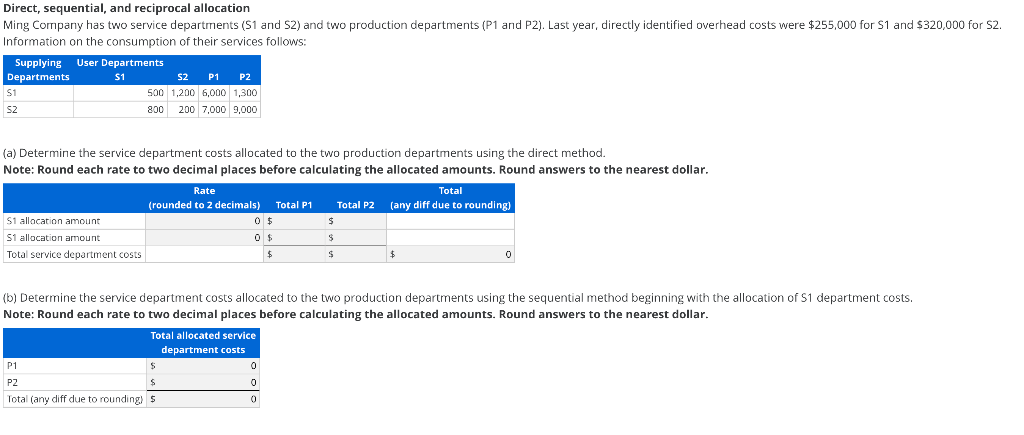Question
Direct, sequential, and reciprocal allocation Ming Company has two service departments (S1 and S2) and two production departments (P1 and P2). Last year, directly identified
Direct, sequential, and reciprocal allocation Ming Company has two service departments (S1 and S2) and two production departments (P1 and P2). Last year, directly identified overhead costs were $255,000 for S1 and $320,000 for S2. Information on the consumption of their services follows:
| Supplying | User Departments | |||
|---|---|---|---|---|
| Departments | S1 | S2 | P1 | P2 |
| S1 | 500 | 1,200 | 6,000 | 1,300 |
| S2 | 800 | 200 | 7,000 | 9,000 |
(a) Determine the service department costs allocated to the two production departments using the direct method. Note: Round each rate to two decimal places before calculating the allocated amounts. Round answers to the nearest dollar.
| Rate | Total | |||
|---|---|---|---|---|
| (rounded to 2 decimals) | Total P1 | Total P2 | (any diff due to rounding) | |
| S1 allocation amount | Answer in % | Answer in $ | Answer in $ | |
| S1 allocation amount | Answer in % | Answer in $ | Answer in $ | |
| Total service department costs | Answer in $ | Answer in $ | Answer in $ |
(b) Determine the service department costs allocated to the two production departments using the sequential method beginning with the allocation of S1 department costs. Note: Round each rate to two decimal places before calculating the allocated amounts. Round answers to the nearest dollar.
| Total allocated service | |
|---|---|
| department costs | |
| P1 | Answer in $ |
| P2 | Answer in $ |
| Total (any diff due to rounding) | Answer in $ |
(c) Determine the service department costs allocated to the two production departments using the reciprocal method.
Note: Do not round your computations; however, round your final answers to the nearest dollar.
| Total allocated service | |
|---|---|
| department costs | |
| P1 | Answer in $ |
| P2 | Answer in $ |
| Answer in $ |


Step by Step Solution
There are 3 Steps involved in it
Step: 1

Get Instant Access to Expert-Tailored Solutions
See step-by-step solutions with expert insights and AI powered tools for academic success
Step: 2

Step: 3

Ace Your Homework with AI
Get the answers you need in no time with our AI-driven, step-by-step assistance
Get Started


